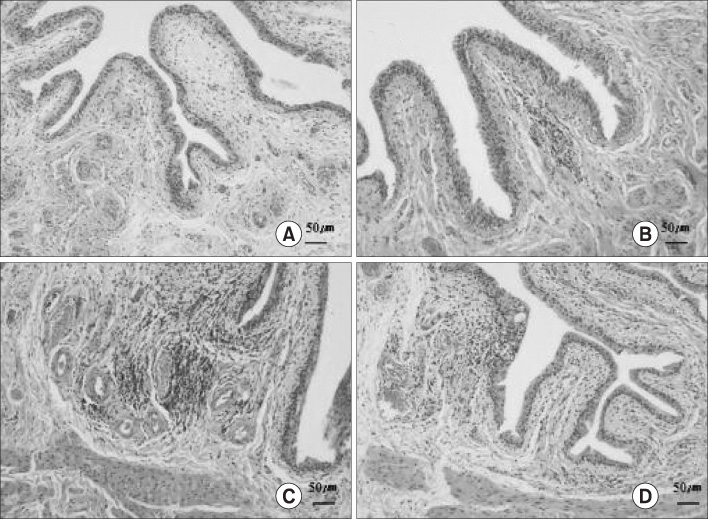Korean J Urol.
2009 Dec;50(12):1253-1257.
Antimicrobial Effect of Lactobacillus in a Rat Model of Escherichia coli Urinary Tract Infection: A Preliminary Study
- Affiliations
-
- 1Department of Urology, College of Medicine, The Catholic University of Korea, Seoul, Korea. urohan@catholic.ac.kr
Abstract
- PURPOSE
Urinary tract infection (UTI) is one of the most common infectious diseases. There are reports that loss or destruction of normal urinary flora such as Lactobacillus increases UTI, and in more recent reports, human urinary epithelial cells have been found to competitively block uropathogen conjugation. We investigated the blocking effect of the Lactobacillus rhamnosus in a rat model of UTI caused by Escherichia coli.
MATERIALS AND METHODS
Thirty-two adult female Sprague-Dawley rats weighing 250 to 350 g (Samtako BioKorea, Osan, South Korea) were randomly divided into 4 groups (Group I, control group; Group II, Lactobacillus group; Group III, E. coli group; Group IV, E. coli and Lactobacillus group). After 3 weeks, the urine and bladder were cultured for microbiological study and the bladder was examined histopathologically.
RESULTS
Microbiological culture of urine demonstrated no significant differences in the four groups, but there were significantly fewer bacteria in group IV than in group III (p<0.05). The bacterial growth of the bladder tissue showed the same result. Histological exam of the bladder of group IV showed decreased infiltration of leukocytes and less submucosal edema than in group III.
CONCLUSIONS
We were able to confirm the blocking effect of L. rhamnosus on E. coli growth. More studies are needed to further identify the therapeutic effect of Lactobacillus and to determine the optimal lactobacilli species, dose, and method of administration.
Keyword
MeSH Terms
Figure
Reference
-
1. Ryu KH, Kim MK, Jeong YB. A recent study on the antimicrobial sensitivity of the organisms that cause urinary tract infection. Korean J Urol. 2007. 48:638–645.2. Ko YH, Oh JS, Cho DY, Bea JH, Koh SK. Changes of causative organisms and antimicrobial sensitivity of urinry tract infection between 1979 and 2001. Korean J Urol. 2003. 44:342–350.3. Lane MC, Lockatell V, Monterosso G, Lamphier D, Weinert J, Hebel JR, et al. Role of motility in the colonization of uropathogenic Escherichia coli in the urinary tract. Infect Immun. 2005. 73:7644–7656.4. Snyder JA, Haugen BJ, Lockatell CV, Maroncle N, Hagan EC, Johnson DE, et al. Coordinate expression of fimbriae in uropathogenic Escherichia coli. Infect Immun. 2005. 73:7588–7596.5. Foxman B. Epidemiology of urinary tract infections: incidence, morbidity, and economic costs. Dis Mon. 2003. 49:53–70.6. Stothers L. A randomized trial to evaluate effectiveness and cost effectiveness of naturopathic cranberry products as prophylaxis against urinary tract infection in women. Can J Urol. 2002. 9:1558–1562.7. Jepson RG, Craig JC. A systematic review of the evidence for cranberries and blueberries in UTI prevention. Mol Nutr Food Res. 2007. 51:738–745.8. Yoo C, Kim CS. Complementary and alternative medicine in urology. Korean J Urol. 2008. 49:193–202.9. Redondo-Lopez V, Cook RL, Sobel JD. Emerging role of lactobacilli in the control and maintenance of the vaginal bacterial microflora. Rev Infect Dis. 1990. 12:856–872.10. Schaeffer AJ, Stamey TA. Studies of introital colonization in women with recurrent urinary infections. IX. The role of antimicrobial therapy. J Urol. 1977. 118:221–224.11. Reid G, Beuerman D, Heinemann C, Bruce AW. Probiotic Lactobacillus does required to restore and maintain a normal vaginal flora. FEMS Immunol Med Microbiol. 2001. 32:37–41.12. Borriello SP, Hammes WP, Holzapfel W, Marteau P, Schrezenmeir J, Vaara M, et al. Safety of probiotics that contain lactobacilli or bifidobacteria. Clin Infect Dis. 2003. 36:775–780.13. Salminen MK, Tynkkynen S, Rautelin H, Saxelin M, Vaara M, Ruutu P, et al. Lactobacillus bacteremia during a rapid increase in probiotic use of Lactobacillus rhamnosus GG in Finland. Clin Infect Dis. 2002. 35:1155–1160.14. Barrons R, Tassone D. Use of Lactobacillus probiotics for bacterial genitourinary infections in women: a review. Clin Ther. 2008. 30:453–468.15. Anukam K, Osazuwa E, Ahonkhai L, Ngwu M, Osemene G, Bruce AW, et al. Augmentation of antimicrobial metronidazole therapy of bacterial vaginosis with oral probiotic Lactobacillus rhamnosus GR-1 nad Lactobacillus reuteri RC-14: randomized, double-blind, placebo controlled trial. Microbes Infect. 2006. 8:1450–1454.16. Reid G, Bruce AW, Taylor M. Influence of three-day antimicrobial therapy and Lactobacillus vaginal suppositories on recurrence of urinary tract infections. Clin Ther. 1992. 14:11–16.17. Neri A, Sabah G, Samra Z. Bacterial vaginosis in pregnancy treated with yoghurt. Acta Obstet Gynecol Scand. 1993. 72:17–19.18. Baerheim A, Larsen E, Digranes A. Vaginal application of lactobacilli in the prophylaxis of recurrent lower urinary tract infection in women. Scand J Prim Health Care. 1994. 12:239–243.19. Reid G, Bruce AW, Taylor M. Instillation of Lactobacillus and stimulation of indigenous organisms to prevent recurrence of urinary tract infections. Microecol Ther. 1995. 23:32–45.20. Kontiokari T, Sundqvist K, Nuutinen M, Pokka T, Koskela M, Uhari M. Randomised trial of cranberry-lingonberry juice and Lactobacillus GG drink for the prevention of urinary tract infections in women. BMJ. 2001. 322:1571.21. Asahara T, Nomoto K, Watanuki M, Yokokura T. Antimicrobial activity of intraurethrally administered probiotic Lactobacillus casei in a murine model of Escherichia coli urinary tract infection. Antimicrob Agents Chemother. 2001. 45:1751–1760.
- Full Text Links
- Actions
-
Cited
- CITED
-
- Close
- Share
- Similar articles
-
- Urinary Tract Infection Caused by Escherichia coli
- O serotypes of escherichia coli isolated from patients with urinary tract infections
- Characterization of Escherichia coli isolated from Urinary Tract Infection
- Comparison of Escherichia coli and Klebsiella pneumoniae Acute Pyelonephritis in Korean Patients
- Unexpected Septic Shock after Ureteroscopic Lithotripsy in a Patient Preoperatively Treated for a Urinary Tract Infection


